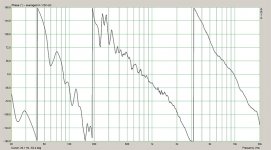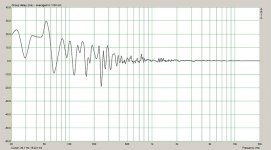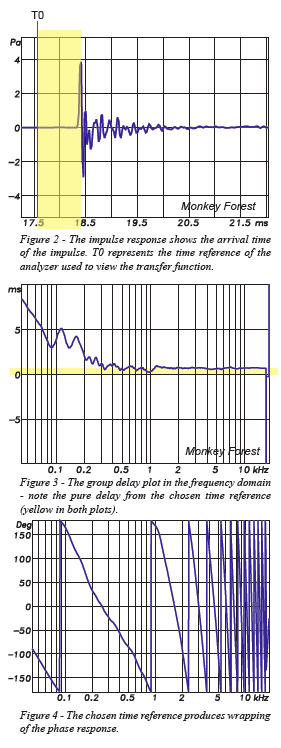Hand-in-Hand Phase and Group Delay Pro Sound Training
In well designed speaker systems, a Major problem is GD at low end... low freq. only ----->
View attachment 487112
View attachment 487114 EQ of GD
Another way is to extend the FR of speakers to very low Freq and then GD will be lowered down to lowest music freq.
-RNM
Richard, the hand-writing on the 2nd graph you posed looks like Siggi Linkwitz, is that so?
Jan
Jan,
That article in Italian from vuki though I can't read the writing I can understand the materials used, easy to know what those words mean as I look at the waterfall plots and the FR plots there doesn't look like much to suggest that is a very nice sounding speaker system. It still uses a down firing dynamic driver which also doesn't look like the composite match to the upper device is all that nice. And if that is the cost and I think those dollars are still more than the exchange with the US dollar that is a lot of money for something that besides tbe somewhat omnidirectional sound I just see little to attract me to even want to hear it. 36K Euro, oh my.
That article in Italian from vuki though I can't read the writing I can understand the materials used, easy to know what those words mean as I look at the waterfall plots and the FR plots there doesn't look like much to suggest that is a very nice sounding speaker system. It still uses a down firing dynamic driver which also doesn't look like the composite match to the upper device is all that nice. And if that is the cost and I think those dollars are still more than the exchange with the US dollar that is a lot of money for something that besides tbe somewhat omnidirectional sound I just see little to attract me to even want to hear it. 36K Euro, oh my.
George, ....
I guess that we can place an electrostatic speaker in the DML catagory as that would seem to describe the function as close as I can understand to the mode the diaphragm is functioning under, barring the much greater distribution of the driving forces.
As that U-Tube video .....
A typical electrostatic driver is not DML. It driven pistonic over the area that is in the electrostatic field. At least that is the intention.
//
I have asked this to myself, alas I can not locate a patent.How is this different than the Ohm Walsh driver?
Has anyone considered the peak acoustic power 4 brass instruments can produce?
Brass instrument (lip reed) acoustics: an introduction
Walking on the side of a marching band playing, is a real experience (internal organ’s massage)
Thank you for the link Scott.
It is a very good modern version of A. H. Benade writings
https://ccrma.stanford.edu/marl/Benade/writings/58to69.html
Now forget for a moment the technicalities and enjoy:
https://www.youtube.com/watch?v=x2mfGqFzGCo
George
Yes. Real delay is just straight up time from here to there. Offset drivers is a good example. Then there is the delay created by phase change. And, finally we have the mystery delay -- 'group delay'. Its the group delay which i have been talking about.... and it is mostly a low freq issue in well designed systems.
GD has a large affect on the quality of the low frequency sound. One way is to extend the freq response lower than the music alone requires. It is also why the HP filter to remove the low freq. junk fom TT/LP is so hard to get right.
THx-RNMarsh
Last edited:
Richard, the hand-writing on the 2nd graph you posed looks like Siggi Linkwitz, is that so?
Jan
yes.
One of many such graphs by many people for a long time.
We should pay more attention to reducing it every where we can for best sound quality.... both in recording and reproduction.
THx-RNMarsh
Thank you Vuki, but I can't read Italian, but the graphs are not stellar. Not stellar at all. 36.000 Euro's, that's another thing I understood.
Ahhh - I'm Italian-challenged. I can read the pictures, seems technically a good driver, but what do they say about the sound? There's also a closing para whether the € 36k is justified - what is the conclusion?
Jan
Link to Google Translate version on my G: drive -
https://docs.google.com/document/d/1x3f12NRS2n2CAoslt-xJsKXHtWc9Kq3MtcRH_3bnQws/edit?usp=sharing
Thank you Vuki, but I can't read Italian, but the graphs are not stellar. Not stellar at all. 36.000 Euro's, that's another thing I understood.
As I mentioned before-there are many reviews on German physic site; just scroll to the end of particular product page and there they are -most of them with english translation.
With what I believe, no listenable issues. ;-)and it is mostly a low freq issue in well designed systems.
Last edited:
yes.
One of many such graphs by many people for a long time.
We should pay more attention to reducing it every where we can for best sound quality.... both in recording and reproduction.
THx-RNMarsh
It is unfortunate that SL is in on the conspiracy as well, but let me try to explain again why in my view group delay is an irrelevant measure for audio. These pictures might show more than 2000 words can tell. They are both from a reverberant measurement, just to exacerbate the point a bit for clarity.
The first graph is unwrapped frequency.

The second is the group delay from the same measurement.

Two observations:
1) Group delay can become negative. Look at what happens between 50-something and 65 Hz. The sort of peaks and dips in the FR translate into swings in the phase plot, to the extent that within 15 Hz, the difference in group delay climbs to 40 ms.
Does this imply that the arrival of sound in these frequencies flip-flop 40 ms? No, of course not. Group delay is just a measure of the slope of the phase diagram. When phase advances, group delay becomes negative, and when phase slows, it becomes negative. That is all it measures, and 'ms' is a very misleading quantity to measure it in. It denotes nothing real.
There are HUGE dips and peaks in bass, even in well balanced listening rooms. All these translate in wild swings in the measurement of 'group delay'. It means very little if anything, psycho-acoustically.
To calculate arrival delay above the distance constant, you take phase/frequency. Nothing to do with 'group delay'.
2) Mother nature is logarithmic when it comes to things per second, so it seems. The plots above are made on a logarithmic scale for frequency. This coincides with the way our hearing works, as well as filter orders.
The first 40 Hz are very much not the same as the 40 Hz between 19784 Hz and 19824 Hz (and the first Hz is where all the gremlins are). However, the measure of group delay treats both 40 Hz intervals as the same.
With a relatively gradual rotation of phase as seen in the first plot, the group delay measure gets heavily skewed towards the bottom end, without representing any relevant phenomenon in the real world..
Have fun with the math.
Last edited:
Exactly. The meaning of negative GD values offends causality for most of the common misdescriptions and misuses of it in audio....Group delay can become negative. Look at what happens between 50-something and 65 Hz. The sort of peaks and dips in the FR translate into swings in the phase plot, to the extent that within 15 Hz, the difference in group delay climbs to 40 ms.
Does this imply that the arrival of sound in these frequencies flip-flop 40 ms? No, of course not. Group delay is just a measure of the slope of the phase diagram. When phase advances, group delay becomes negative, and when phase slows, it becomes negative. That is all it measures, and 'ms' is a very misleading quantity to measure it in. It denotes nothing real.
For those still in a brass mood, here's our very own James Morrison, with plenty of acoustic space around it all - https://www.youtube.com/watch?v=DRtfWuawEWU.
If you're a big band music freak, the recordings by the Royal Australian Navy Band are brilliant, with a huge, intense sound to them, I went through from the local library collection, beats the pants off of most of the stuff around,  .
.
Unfortunately, the situation is this, Ordering a Navy Band CD | Royal Australian Navy, bugger ... !!
Unfortunately, the situation is this, Ordering a Navy Band CD | Royal Australian Navy, bugger ... !!
It is unfortunate that SL is in on the conspiracy as well, but let me try to explain again why in my view group delay is an irrelevant measure for audio. These pictures might show more than 2000 words can tell. They are both from a reverberant measurement, just to exacerbate the point a bit for clarity.
The first graph is unwrapped frequency.
View attachment 487153
The second is the group delay from the same measurement.
View attachment 487152
Two observations:
1) Group delay can become negative. Look at what happens between 50-something and 65 Hz. The sort of peaks and dips in the FR translate into swings in the phase plot, to the extent that within 15 Hz, the difference in group delay climbs to 40 ms.
Does this imply that the arrival of sound in these frequencies flip-flop 40 ms? No, of course not. Group delay is just a measure of the slope of the phase diagram. When phase advances, group delay becomes negative, and when phase slows, it becomes negative. That is all it measures, and 'ms' is a very misleading quantity to measure it in. It denotes nothing real.
There are HUGE dips and peaks in bass, even in well balanced listening rooms. All these translate in wild swings in the measurement of 'group delay'. It means very little if anything, psycho-acoustically.
To calculate arrival delay above the distance constant, you take phase/frequency. Nothing to do with 'group delay'.
2) Mother nature is logarithmic when it comes to things per second, so it seems. The plots above are made on a logarithmic scale for frequency. This coincides with the way our hearing works, as well as filter orders.
The first 40 Hz are very much not the same as the 40 Hz between 19784 Hz and 19824 Hz (and the first Hz is where all the gremlins are). However, the measure of group delay treats both 40 Hz intervals as the same.
With a relatively gradual rotation of phase as seen in the first plot, the group delay measure gets heavily skewed towards the bottom end, without representing any relevant phenomenon in the real world..
Have fun with the math.
Gradual rotation in first plot? >1000 degrees; what this plot shows is that energy peak is occurring about 200 microseconds after center of measurement window.
The group delay plot shows that measurement window is long enough to capture modal behavior in room (from looks a typical domestic listening space).
Yes, do the math and work the units. Time v frequency.
Group delay is real, and well studied for a long time.
Gradual rotation in first plot? >1000 degrees; what this plot shows is that energy peak is occurring about 200 microseconds after center of measurement window.
The group delay plot shows that measurement window is long enough to capture modal behavior in room (from looks a typical domestic listening space).
Yes, do the math and work the units. Time v frequency.
Group delay is real, and well studied for a long time.
I agree with you and have dealt with GD for decades..... I cant bring myself to go point for point to argue because there is much wrong about the conditions, interpretation and conclusion(s). It isnt what research has shown and my own experience of its affect on timbre.
I need to say one thing about the conditions..... a highly reverb room is Not the best listening conditions and makes GD harder to detect. Also, dont leave out headphone listening which is very popular now with headphones which are light-years ahead of what used to be available.
So, if there is some poo-poo of it then that is an individual matter. The rest can try to do better and find the conditions right for it... even if it has to be done in DSP.
more -- http://www.audiodesignguide.com/Sub/SIGroupDelay.pdf
THx-RNMarsh
Last edited:
So, in your explanation, how does negative group delay arise, and why doesn't it offend causality ?I agree with you and have dealt with GD for decades..... I cant bring myself to go point for point to argue because there is much wrong about the conditions, interpretation and conclusion(s).
Gradual rotation in first plot? >1000 degrees; what this plot shows is that energy peak is occurring about 200 microseconds after center of measurement window.
The group delay plot shows that measurement window is long enough to capture modal behavior in room (from looks a typical domestic listening space).
The phase shift is exactly as theory would predict to happen with a 3 way loudspeaker of the BR variety. Three 4th order filters (the enclosure and the 2 xover points) deliver 3*360 degrees of phase shift.
You are right that the measurement window is long enough to pick up room modes and other reflections; I mentioned that I was showing a reverbarent plot to make things clearer.
Ok, Richard. The question I ask myself is why are-you so upset about this group delay at very low frequencies ? What are-you trying to underline ?a highly reverb room is Not the best listening conditions and makes GD harder to detect. Also, dont leave out headphone listening which is very popular now with headphones which are light-years ahead of what used to be available.
Are bass reflex so bad on subjective listening ? I don't think so. And, with a good enough dumping and correct tuning, it can sound even "faster" than closed enclosures (personal opinion here).
I mean, the hit of the kick drums or the attack of the basse arrive before their body. This helps for their space localisation.
Now, the room. Our ears+brain are very good to discriminate first signals from their room's first reflections. In fact, from our origins, we use phases correlation to stay alive, helping-us to localize the source of a noise witch can be the sign of a predator (or some animal good to be hunted ;-). This discrimination is maximized at our max sensitivity frequencies (3KHz). It is around here that GD matters the most. And it is not as much the absolute value than the absence of brutal accident that matters, not ?
And our ears use various ways to discriminate and localize. Including binaural level differences. The proof ? We use most of the time no delay with our mixing desk pan pots and... it seems to work good enough ;-)
Last edited:
- Status
- Not open for further replies.
- Home
- Member Areas
- The Lounge
- John Curl's Blowtorch preamplifier part II
